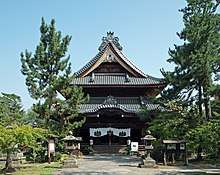Shinano Kokubun-ji
Shinano Kokubun-ji (信濃国分寺) is a Tendai sect Buddhist temple located in the city of Ueda, Nagano, Japan. Its honzon is Yakushi Nyorai. It is the successor to one of the provincial temples established by Emperor Shōmu during the Nara period (710 – 794) for the purpose of promoting Buddhism as the national religion of Japan and standardising control of the Yamato rule to the provinces.[1] The archaeological site with the ruins of the ancient temple grounds was designated as a National Historic Site by the Japanese government in 1974. [2]
| Shinano Kokubun-ji | |
|---|---|
信濃国分寺 | |
 Shinano Kokubun-ji Main Hall | |
| Religion | |
| Affiliation | Buddhist |
| Deity | Yakushi Nyorai |
| Rite | Tendai |
| Location | |
| Location | Ueda, Nagano |
| Country | Japan |
 Shown within Nagano Prefecture  Shinano Kokubun-ji (Japan) | |
| Geographic coordinates | 36°22′50″N 138°16′14″E |
| Architecture | |
| Founder | Emperor Shōmu |
| Website | |
| Official website | |
History
The temple is located in the Ueda Basin on the north bank of the Chikuma River, with the ruins of the ancient Kokubun-ji located 300 meters to the south of the current temple. It is believed that the ancient provincial capital of Shinano Province was located nearby; however, excavation surveys indicate that the Kokubun-ji ruins are not the original Nara-period provincial temple, but are an early Heian period reconstruction. The exact date of this Heian period foundation is uncertain, and traces of a fire lend some credence to temple legend that it was burned down in a battle between the armies of the central government and the forces of the rebel Taira no Masakado in 938 AD. However, many other provincial temples around the country were destroyed during this period, due to a decline in the authority of the central government and rise of competing local warlords. The temple retains a stone pagoda monument and a wooden three-story pagoda both of which are from the Kamakura period,
Current situation
The present main hall, a Yakushi-dō was completed in 1860. It has two sets of eaves, giving it the outward appearance of a two-story structure, but the building interior has only single story. It is designed as a Nagano Prefectural Important Cultural Property.
The 20.1 meter tall Three-story Pagoda was built in 1197 with the sponsorship of Minamoto no Yoritomo; however, judging from its style, the existing structure dates from the middle of the Muromachi period. It houses a statue of Dainichi Nyorai. The structure is designed as a National Important Cultural Property.
The ruins of the ancient Kokubun-ji are a square enclosure measuring 176.56 meters east-west by 178.05 meters north-south. Within this enclosure, the foundation stones for a Main Hall, Lecture Hall, Great South Gate, Middle Gate and Pagoda, with a surrounding Cloister have been preserved. These ruins were adjacent to the Kokubun-niiji, or Provincial nunnery, whose layout and size was almost identical. The two sites today are separated by a railroad line, but both are preserved as part of an archaeological park.
References
- "Kokubunji". Encyclopedia of Japan. Tokyo: Shogakukan. 2012. Archived from the original on 2007-08-25. Retrieved 2012-05-04.
- "信濃国分寺跡" (in Japanese). Agency for Cultural Affairs.
External links
![]()
- Ueda City official site (in Japanese)